TH60053E: Airport Planning and Development
VerifiedAdded on 2020/04/29
|11
|2495
|171
AI Summary
Contribute Materials
Your contribution can guide someone’s learning journey. Share your
documents today.
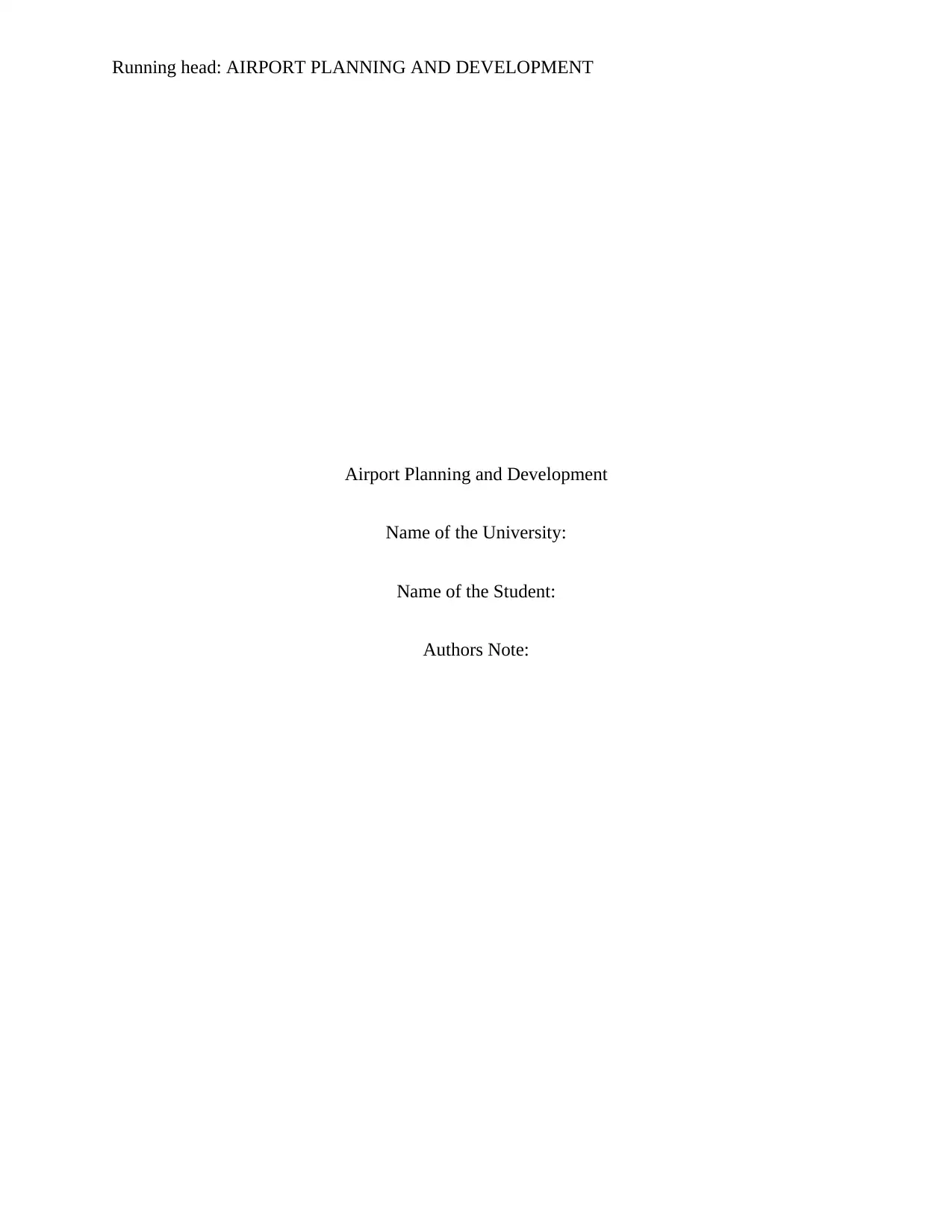
Running head: AIRPORT PLANNING AND DEVELOPMENT
Airport Planning and Development
Name of the University:
Name of the Student:
Authors Note:
Airport Planning and Development
Name of the University:
Name of the Student:
Authors Note:
Secure Best Marks with AI Grader
Need help grading? Try our AI Grader for instant feedback on your assignments.
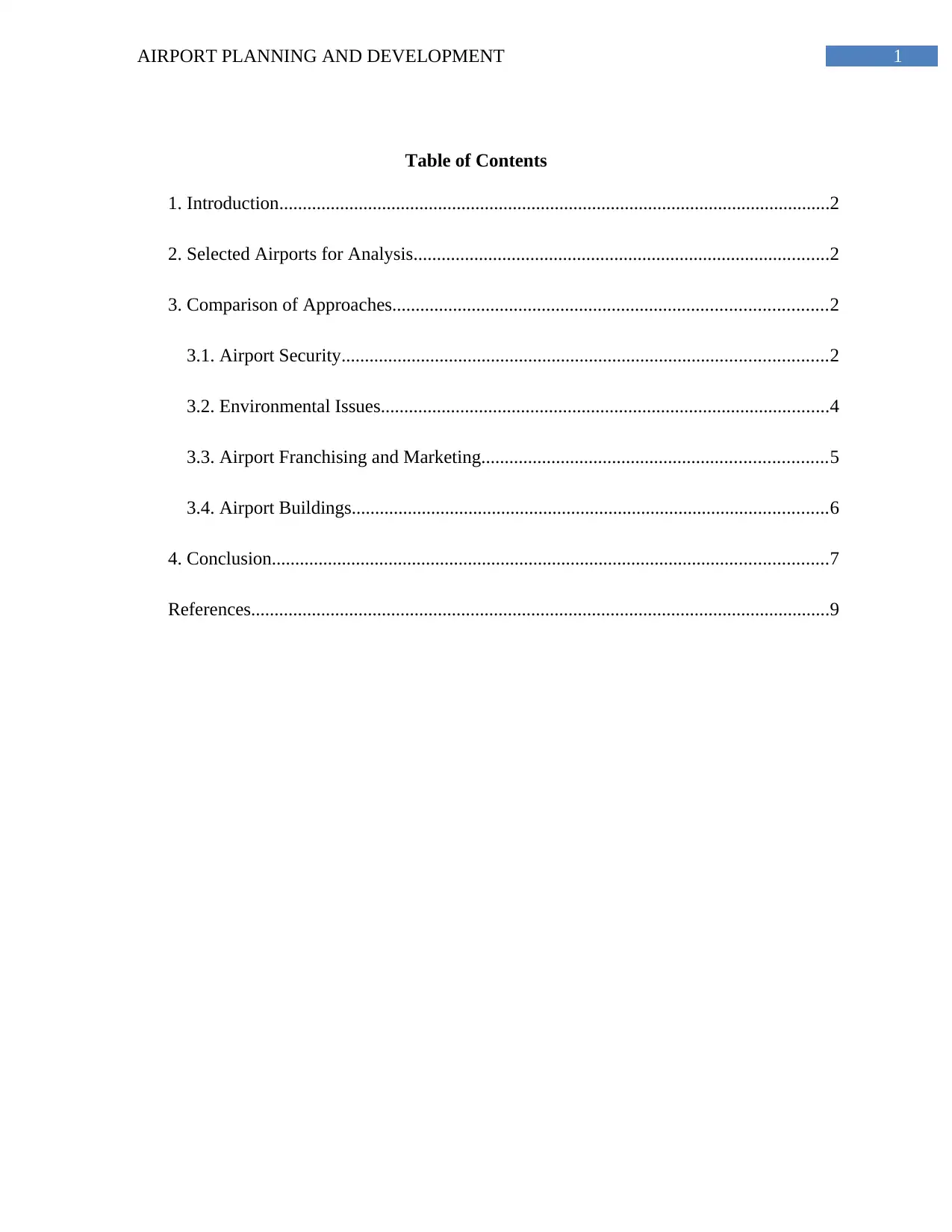
1AIRPORT PLANNING AND DEVELOPMENT
Table of Contents
1. Introduction......................................................................................................................2
2. Selected Airports for Analysis.........................................................................................2
3. Comparison of Approaches.............................................................................................2
3.1. Airport Security........................................................................................................2
3.2. Environmental Issues................................................................................................4
3.3. Airport Franchising and Marketing..........................................................................5
3.4. Airport Buildings......................................................................................................6
4. Conclusion.......................................................................................................................7
References............................................................................................................................9
Table of Contents
1. Introduction......................................................................................................................2
2. Selected Airports for Analysis.........................................................................................2
3. Comparison of Approaches.............................................................................................2
3.1. Airport Security........................................................................................................2
3.2. Environmental Issues................................................................................................4
3.3. Airport Franchising and Marketing..........................................................................5
3.4. Airport Buildings......................................................................................................6
4. Conclusion.......................................................................................................................7
References............................................................................................................................9
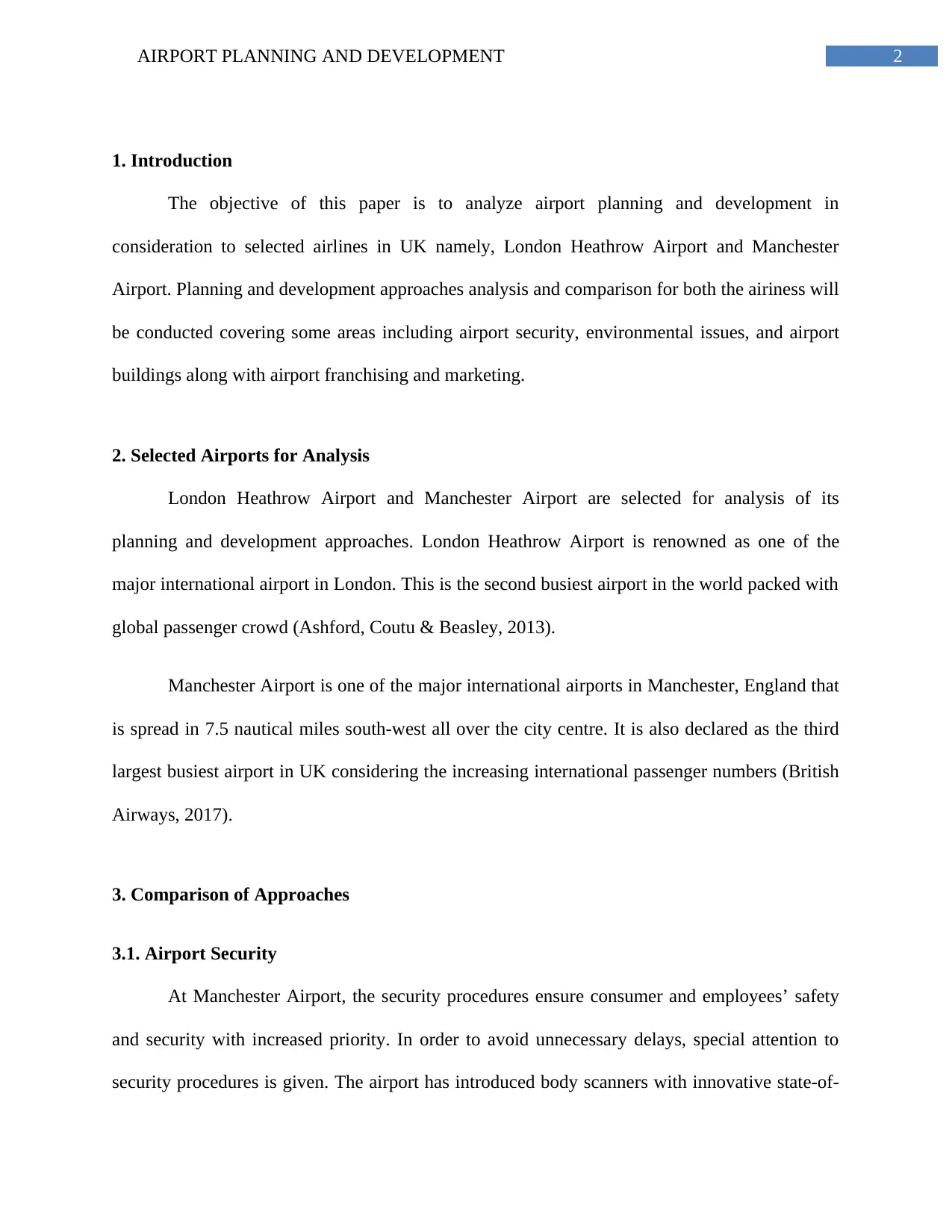
2AIRPORT PLANNING AND DEVELOPMENT
1. Introduction
The objective of this paper is to analyze airport planning and development in
consideration to selected airlines in UK namely, London Heathrow Airport and Manchester
Airport. Planning and development approaches analysis and comparison for both the airiness will
be conducted covering some areas including airport security, environmental issues, and airport
buildings along with airport franchising and marketing.
2. Selected Airports for Analysis
London Heathrow Airport and Manchester Airport are selected for analysis of its
planning and development approaches. London Heathrow Airport is renowned as one of the
major international airport in London. This is the second busiest airport in the world packed with
global passenger crowd (Ashford, Coutu & Beasley, 2013).
Manchester Airport is one of the major international airports in Manchester, England that
is spread in 7.5 nautical miles south-west all over the city centre. It is also declared as the third
largest busiest airport in UK considering the increasing international passenger numbers (British
Airways, 2017).
3. Comparison of Approaches
3.1. Airport Security
At Manchester Airport, the security procedures ensure consumer and employees’ safety
and security with increased priority. In order to avoid unnecessary delays, special attention to
security procedures is given. The airport has introduced body scanners with innovative state-of-
1. Introduction
The objective of this paper is to analyze airport planning and development in
consideration to selected airlines in UK namely, London Heathrow Airport and Manchester
Airport. Planning and development approaches analysis and comparison for both the airiness will
be conducted covering some areas including airport security, environmental issues, and airport
buildings along with airport franchising and marketing.
2. Selected Airports for Analysis
London Heathrow Airport and Manchester Airport are selected for analysis of its
planning and development approaches. London Heathrow Airport is renowned as one of the
major international airport in London. This is the second busiest airport in the world packed with
global passenger crowd (Ashford, Coutu & Beasley, 2013).
Manchester Airport is one of the major international airports in Manchester, England that
is spread in 7.5 nautical miles south-west all over the city centre. It is also declared as the third
largest busiest airport in UK considering the increasing international passenger numbers (British
Airways, 2017).
3. Comparison of Approaches
3.1. Airport Security
At Manchester Airport, the security procedures ensure consumer and employees’ safety
and security with increased priority. In order to avoid unnecessary delays, special attention to
security procedures is given. The airport has introduced body scanners with innovative state-of-
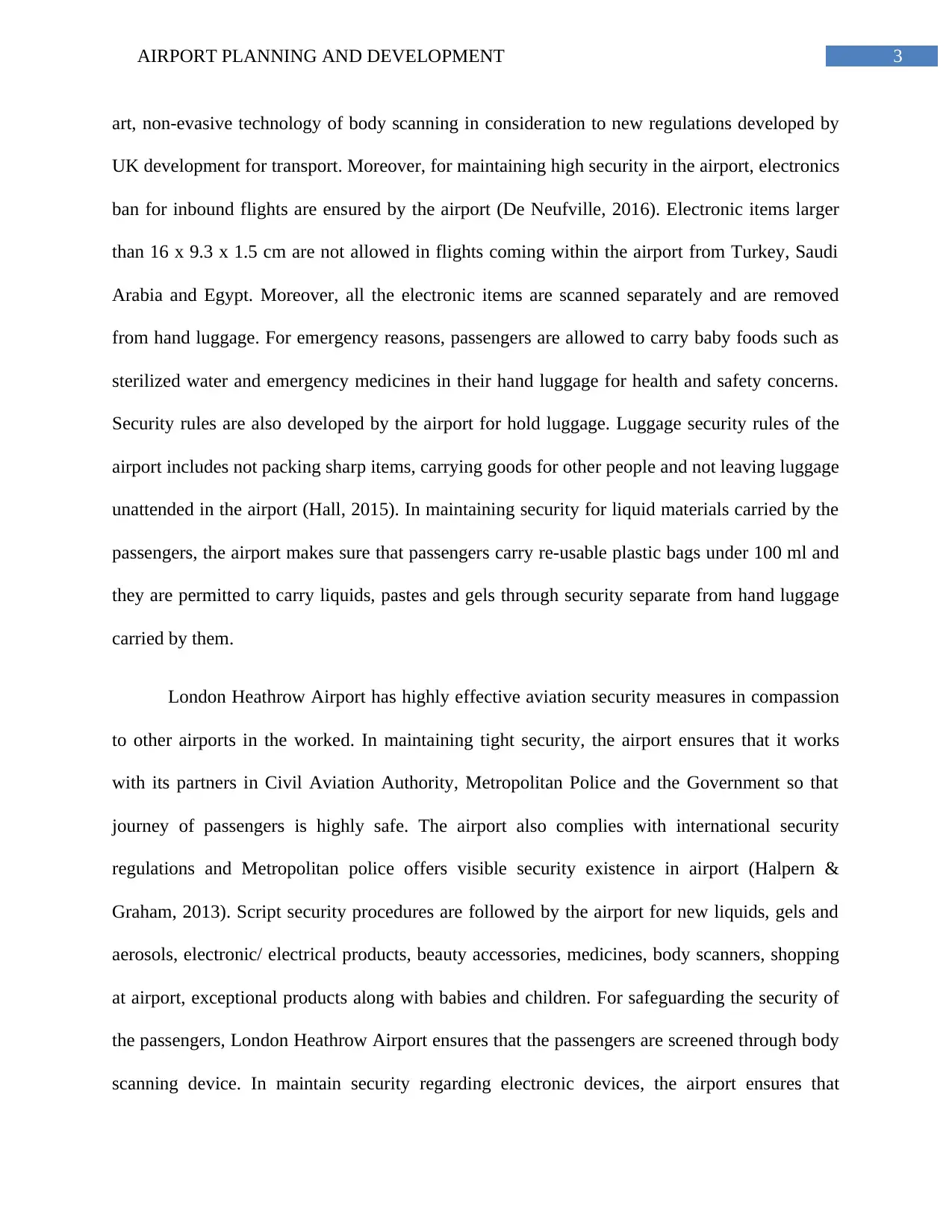
3AIRPORT PLANNING AND DEVELOPMENT
art, non-evasive technology of body scanning in consideration to new regulations developed by
UK development for transport. Moreover, for maintaining high security in the airport, electronics
ban for inbound flights are ensured by the airport (De Neufville, 2016). Electronic items larger
than 16 x 9.3 x 1.5 cm are not allowed in flights coming within the airport from Turkey, Saudi
Arabia and Egypt. Moreover, all the electronic items are scanned separately and are removed
from hand luggage. For emergency reasons, passengers are allowed to carry baby foods such as
sterilized water and emergency medicines in their hand luggage for health and safety concerns.
Security rules are also developed by the airport for hold luggage. Luggage security rules of the
airport includes not packing sharp items, carrying goods for other people and not leaving luggage
unattended in the airport (Hall, 2015). In maintaining security for liquid materials carried by the
passengers, the airport makes sure that passengers carry re-usable plastic bags under 100 ml and
they are permitted to carry liquids, pastes and gels through security separate from hand luggage
carried by them.
London Heathrow Airport has highly effective aviation security measures in compassion
to other airports in the worked. In maintaining tight security, the airport ensures that it works
with its partners in Civil Aviation Authority, Metropolitan Police and the Government so that
journey of passengers is highly safe. The airport also complies with international security
regulations and Metropolitan police offers visible security existence in airport (Halpern &
Graham, 2013). Script security procedures are followed by the airport for new liquids, gels and
aerosols, electronic/ electrical products, beauty accessories, medicines, body scanners, shopping
at airport, exceptional products along with babies and children. For safeguarding the security of
the passengers, London Heathrow Airport ensures that the passengers are screened through body
scanning device. In maintain security regarding electronic devices, the airport ensures that
art, non-evasive technology of body scanning in consideration to new regulations developed by
UK development for transport. Moreover, for maintaining high security in the airport, electronics
ban for inbound flights are ensured by the airport (De Neufville, 2016). Electronic items larger
than 16 x 9.3 x 1.5 cm are not allowed in flights coming within the airport from Turkey, Saudi
Arabia and Egypt. Moreover, all the electronic items are scanned separately and are removed
from hand luggage. For emergency reasons, passengers are allowed to carry baby foods such as
sterilized water and emergency medicines in their hand luggage for health and safety concerns.
Security rules are also developed by the airport for hold luggage. Luggage security rules of the
airport includes not packing sharp items, carrying goods for other people and not leaving luggage
unattended in the airport (Hall, 2015). In maintaining security for liquid materials carried by the
passengers, the airport makes sure that passengers carry re-usable plastic bags under 100 ml and
they are permitted to carry liquids, pastes and gels through security separate from hand luggage
carried by them.
London Heathrow Airport has highly effective aviation security measures in compassion
to other airports in the worked. In maintaining tight security, the airport ensures that it works
with its partners in Civil Aviation Authority, Metropolitan Police and the Government so that
journey of passengers is highly safe. The airport also complies with international security
regulations and Metropolitan police offers visible security existence in airport (Halpern &
Graham, 2013). Script security procedures are followed by the airport for new liquids, gels and
aerosols, electronic/ electrical products, beauty accessories, medicines, body scanners, shopping
at airport, exceptional products along with babies and children. For safeguarding the security of
the passengers, London Heathrow Airport ensures that the passengers are screened through body
scanning device. In maintain security regarding electronic devices, the airport ensures that
Secure Best Marks with AI Grader
Need help grading? Try our AI Grader for instant feedback on your assignments.
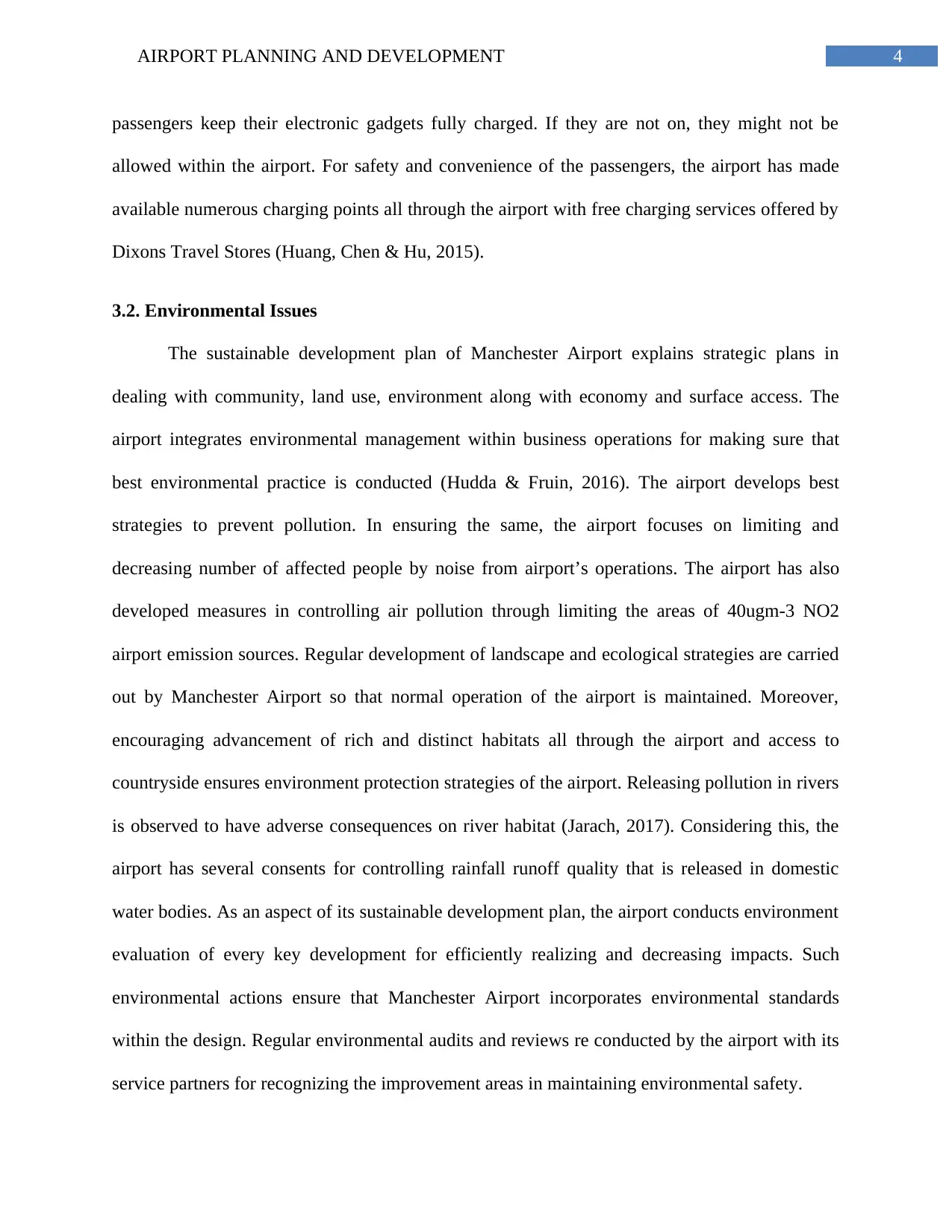
4AIRPORT PLANNING AND DEVELOPMENT
passengers keep their electronic gadgets fully charged. If they are not on, they might not be
allowed within the airport. For safety and convenience of the passengers, the airport has made
available numerous charging points all through the airport with free charging services offered by
Dixons Travel Stores (Huang, Chen & Hu, 2015).
3.2. Environmental Issues
The sustainable development plan of Manchester Airport explains strategic plans in
dealing with community, land use, environment along with economy and surface access. The
airport integrates environmental management within business operations for making sure that
best environmental practice is conducted (Hudda & Fruin, 2016). The airport develops best
strategies to prevent pollution. In ensuring the same, the airport focuses on limiting and
decreasing number of affected people by noise from airport’s operations. The airport has also
developed measures in controlling air pollution through limiting the areas of 40ugm-3 NO2
airport emission sources. Regular development of landscape and ecological strategies are carried
out by Manchester Airport so that normal operation of the airport is maintained. Moreover,
encouraging advancement of rich and distinct habitats all through the airport and access to
countryside ensures environment protection strategies of the airport. Releasing pollution in rivers
is observed to have adverse consequences on river habitat (Jarach, 2017). Considering this, the
airport has several consents for controlling rainfall runoff quality that is released in domestic
water bodies. As an aspect of its sustainable development plan, the airport conducts environment
evaluation of every key development for efficiently realizing and decreasing impacts. Such
environmental actions ensure that Manchester Airport incorporates environmental standards
within the design. Regular environmental audits and reviews re conducted by the airport with its
service partners for recognizing the improvement areas in maintaining environmental safety.
passengers keep their electronic gadgets fully charged. If they are not on, they might not be
allowed within the airport. For safety and convenience of the passengers, the airport has made
available numerous charging points all through the airport with free charging services offered by
Dixons Travel Stores (Huang, Chen & Hu, 2015).
3.2. Environmental Issues
The sustainable development plan of Manchester Airport explains strategic plans in
dealing with community, land use, environment along with economy and surface access. The
airport integrates environmental management within business operations for making sure that
best environmental practice is conducted (Hudda & Fruin, 2016). The airport develops best
strategies to prevent pollution. In ensuring the same, the airport focuses on limiting and
decreasing number of affected people by noise from airport’s operations. The airport has also
developed measures in controlling air pollution through limiting the areas of 40ugm-3 NO2
airport emission sources. Regular development of landscape and ecological strategies are carried
out by Manchester Airport so that normal operation of the airport is maintained. Moreover,
encouraging advancement of rich and distinct habitats all through the airport and access to
countryside ensures environment protection strategies of the airport. Releasing pollution in rivers
is observed to have adverse consequences on river habitat (Jarach, 2017). Considering this, the
airport has several consents for controlling rainfall runoff quality that is released in domestic
water bodies. As an aspect of its sustainable development plan, the airport conducts environment
evaluation of every key development for efficiently realizing and decreasing impacts. Such
environmental actions ensure that Manchester Airport incorporates environmental standards
within the design. Regular environmental audits and reviews re conducted by the airport with its
service partners for recognizing the improvement areas in maintaining environmental safety.
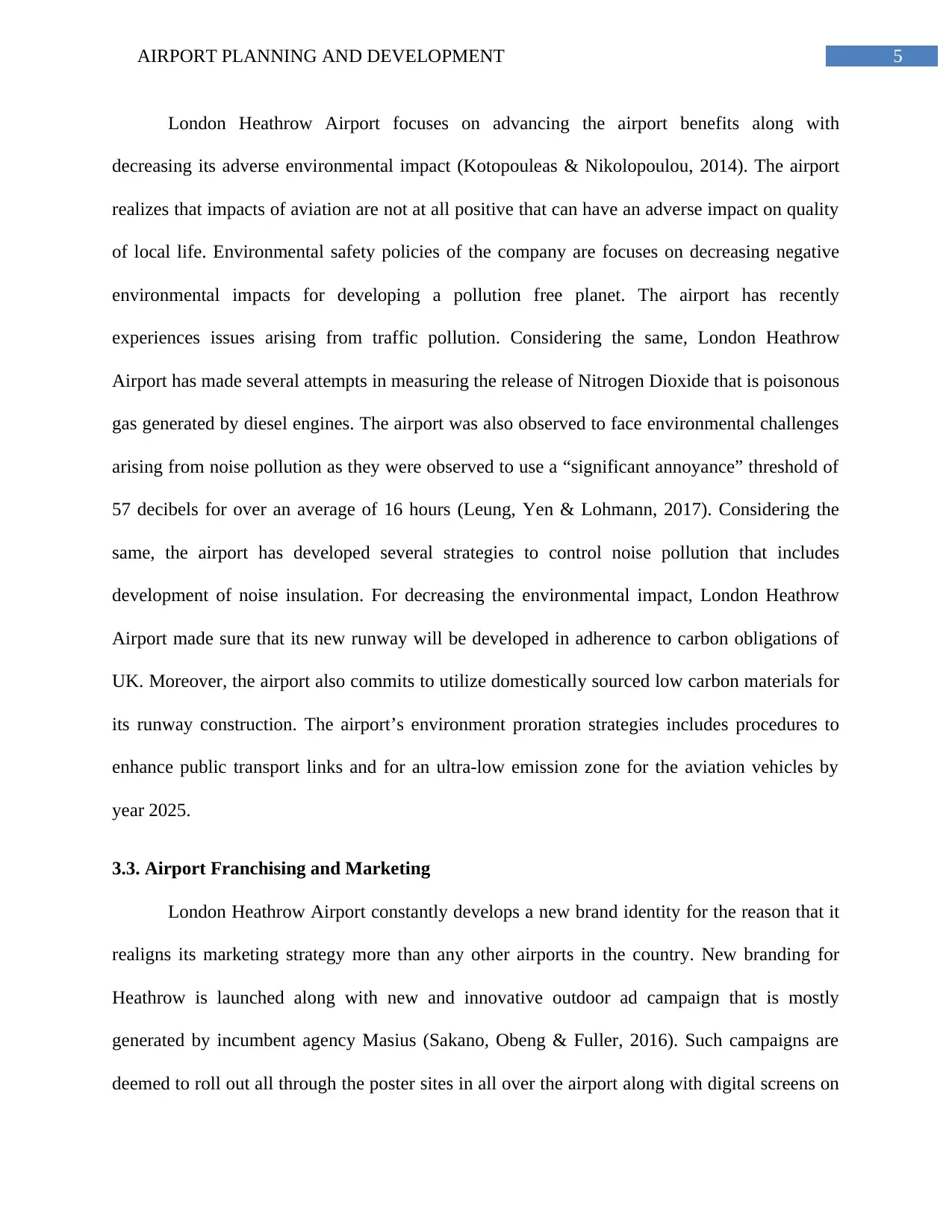
5AIRPORT PLANNING AND DEVELOPMENT
London Heathrow Airport focuses on advancing the airport benefits along with
decreasing its adverse environmental impact (Kotopouleas & Nikolopoulou, 2014). The airport
realizes that impacts of aviation are not at all positive that can have an adverse impact on quality
of local life. Environmental safety policies of the company are focuses on decreasing negative
environmental impacts for developing a pollution free planet. The airport has recently
experiences issues arising from traffic pollution. Considering the same, London Heathrow
Airport has made several attempts in measuring the release of Nitrogen Dioxide that is poisonous
gas generated by diesel engines. The airport was also observed to face environmental challenges
arising from noise pollution as they were observed to use a “significant annoyance” threshold of
57 decibels for over an average of 16 hours (Leung, Yen & Lohmann, 2017). Considering the
same, the airport has developed several strategies to control noise pollution that includes
development of noise insulation. For decreasing the environmental impact, London Heathrow
Airport made sure that its new runway will be developed in adherence to carbon obligations of
UK. Moreover, the airport also commits to utilize domestically sourced low carbon materials for
its runway construction. The airport’s environment proration strategies includes procedures to
enhance public transport links and for an ultra-low emission zone for the aviation vehicles by
year 2025.
3.3. Airport Franchising and Marketing
London Heathrow Airport constantly develops a new brand identity for the reason that it
realigns its marketing strategy more than any other airports in the country. New branding for
Heathrow is launched along with new and innovative outdoor ad campaign that is mostly
generated by incumbent agency Masius (Sakano, Obeng & Fuller, 2016). Such campaigns are
deemed to roll out all through the poster sites in all over the airport along with digital screens on
London Heathrow Airport focuses on advancing the airport benefits along with
decreasing its adverse environmental impact (Kotopouleas & Nikolopoulou, 2014). The airport
realizes that impacts of aviation are not at all positive that can have an adverse impact on quality
of local life. Environmental safety policies of the company are focuses on decreasing negative
environmental impacts for developing a pollution free planet. The airport has recently
experiences issues arising from traffic pollution. Considering the same, London Heathrow
Airport has made several attempts in measuring the release of Nitrogen Dioxide that is poisonous
gas generated by diesel engines. The airport was also observed to face environmental challenges
arising from noise pollution as they were observed to use a “significant annoyance” threshold of
57 decibels for over an average of 16 hours (Leung, Yen & Lohmann, 2017). Considering the
same, the airport has developed several strategies to control noise pollution that includes
development of noise insulation. For decreasing the environmental impact, London Heathrow
Airport made sure that its new runway will be developed in adherence to carbon obligations of
UK. Moreover, the airport also commits to utilize domestically sourced low carbon materials for
its runway construction. The airport’s environment proration strategies includes procedures to
enhance public transport links and for an ultra-low emission zone for the aviation vehicles by
year 2025.
3.3. Airport Franchising and Marketing
London Heathrow Airport constantly develops a new brand identity for the reason that it
realigns its marketing strategy more than any other airports in the country. New branding for
Heathrow is launched along with new and innovative outdoor ad campaign that is mostly
generated by incumbent agency Masius (Sakano, Obeng & Fuller, 2016). Such campaigns are
deemed to roll out all through the poster sites in all over the airport along with digital screens on
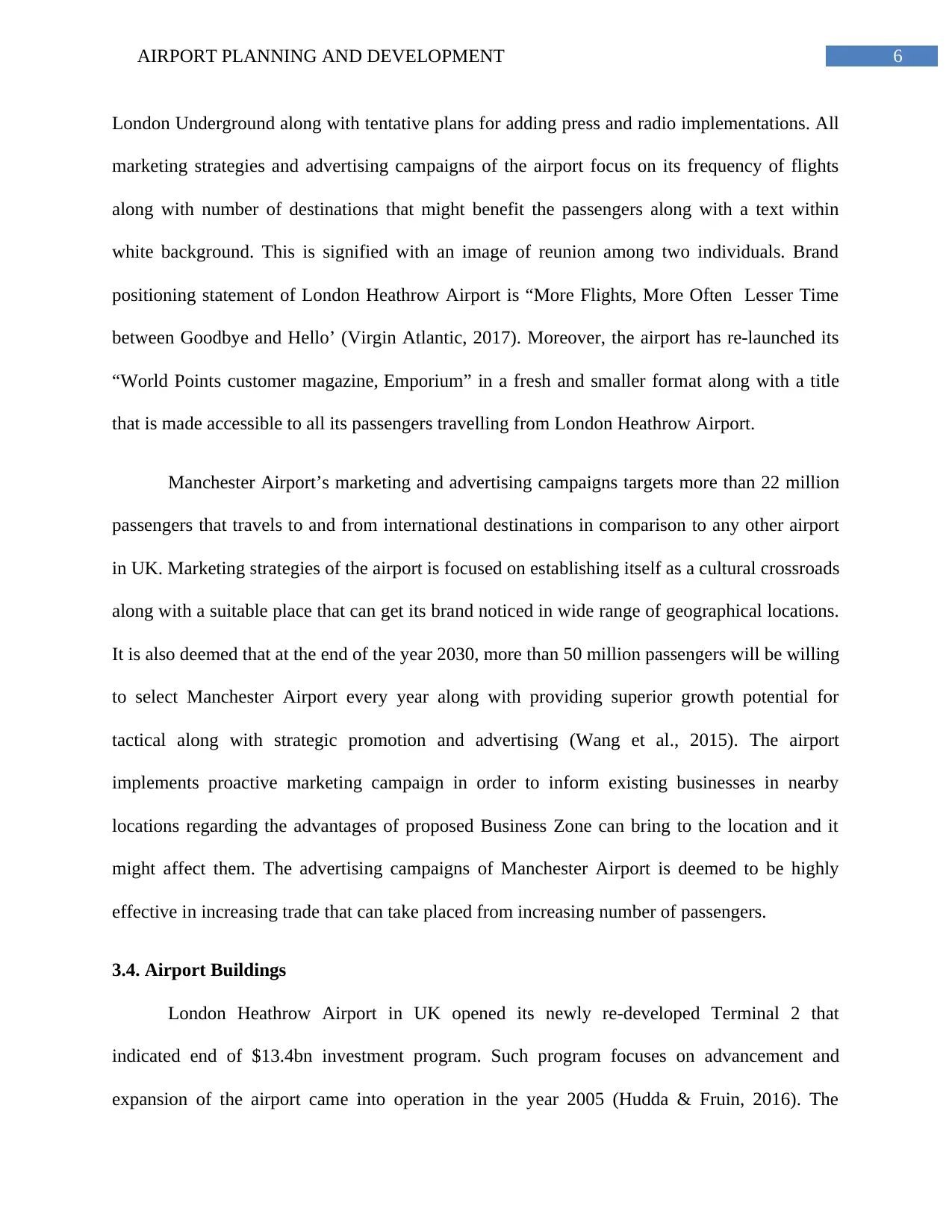
6AIRPORT PLANNING AND DEVELOPMENT
London Underground along with tentative plans for adding press and radio implementations. All
marketing strategies and advertising campaigns of the airport focus on its frequency of flights
along with number of destinations that might benefit the passengers along with a text within
white background. This is signified with an image of reunion among two individuals. Brand
positioning statement of London Heathrow Airport is “More Flights, More Often Lesser Time
between Goodbye and Hello’ (Virgin Atlantic, 2017). Moreover, the airport has re-launched its
“World Points customer magazine, Emporium” in a fresh and smaller format along with a title
that is made accessible to all its passengers travelling from London Heathrow Airport.
Manchester Airport’s marketing and advertising campaigns targets more than 22 million
passengers that travels to and from international destinations in comparison to any other airport
in UK. Marketing strategies of the airport is focused on establishing itself as a cultural crossroads
along with a suitable place that can get its brand noticed in wide range of geographical locations.
It is also deemed that at the end of the year 2030, more than 50 million passengers will be willing
to select Manchester Airport every year along with providing superior growth potential for
tactical along with strategic promotion and advertising (Wang et al., 2015). The airport
implements proactive marketing campaign in order to inform existing businesses in nearby
locations regarding the advantages of proposed Business Zone can bring to the location and it
might affect them. The advertising campaigns of Manchester Airport is deemed to be highly
effective in increasing trade that can take placed from increasing number of passengers.
3.4. Airport Buildings
London Heathrow Airport in UK opened its newly re-developed Terminal 2 that
indicated end of $13.4bn investment program. Such program focuses on advancement and
expansion of the airport came into operation in the year 2005 (Hudda & Fruin, 2016). The
London Underground along with tentative plans for adding press and radio implementations. All
marketing strategies and advertising campaigns of the airport focus on its frequency of flights
along with number of destinations that might benefit the passengers along with a text within
white background. This is signified with an image of reunion among two individuals. Brand
positioning statement of London Heathrow Airport is “More Flights, More Often Lesser Time
between Goodbye and Hello’ (Virgin Atlantic, 2017). Moreover, the airport has re-launched its
“World Points customer magazine, Emporium” in a fresh and smaller format along with a title
that is made accessible to all its passengers travelling from London Heathrow Airport.
Manchester Airport’s marketing and advertising campaigns targets more than 22 million
passengers that travels to and from international destinations in comparison to any other airport
in UK. Marketing strategies of the airport is focused on establishing itself as a cultural crossroads
along with a suitable place that can get its brand noticed in wide range of geographical locations.
It is also deemed that at the end of the year 2030, more than 50 million passengers will be willing
to select Manchester Airport every year along with providing superior growth potential for
tactical along with strategic promotion and advertising (Wang et al., 2015). The airport
implements proactive marketing campaign in order to inform existing businesses in nearby
locations regarding the advantages of proposed Business Zone can bring to the location and it
might affect them. The advertising campaigns of Manchester Airport is deemed to be highly
effective in increasing trade that can take placed from increasing number of passengers.
3.4. Airport Buildings
London Heathrow Airport in UK opened its newly re-developed Terminal 2 that
indicated end of $13.4bn investment program. Such program focuses on advancement and
expansion of the airport came into operation in the year 2005 (Hudda & Fruin, 2016). The
Paraphrase This Document
Need a fresh take? Get an instant paraphrase of this document with our AI Paraphraser
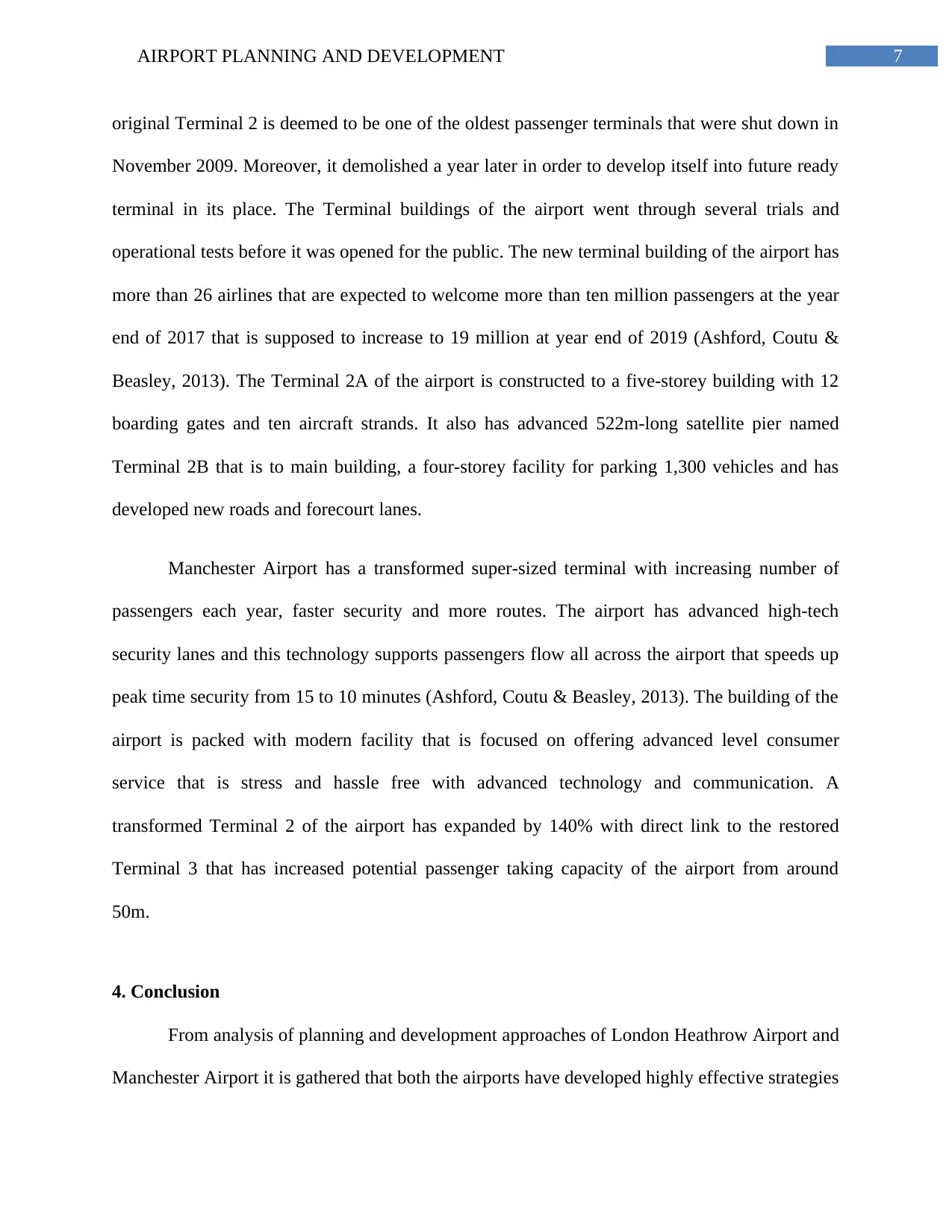
7AIRPORT PLANNING AND DEVELOPMENT
original Terminal 2 is deemed to be one of the oldest passenger terminals that were shut down in
November 2009. Moreover, it demolished a year later in order to develop itself into future ready
terminal in its place. The Terminal buildings of the airport went through several trials and
operational tests before it was opened for the public. The new terminal building of the airport has
more than 26 airlines that are expected to welcome more than ten million passengers at the year
end of 2017 that is supposed to increase to 19 million at year end of 2019 (Ashford, Coutu &
Beasley, 2013). The Terminal 2A of the airport is constructed to a five-storey building with 12
boarding gates and ten aircraft strands. It also has advanced 522m-long satellite pier named
Terminal 2B that is to main building, a four-storey facility for parking 1,300 vehicles and has
developed new roads and forecourt lanes.
Manchester Airport has a transformed super-sized terminal with increasing number of
passengers each year, faster security and more routes. The airport has advanced high-tech
security lanes and this technology supports passengers flow all across the airport that speeds up
peak time security from 15 to 10 minutes (Ashford, Coutu & Beasley, 2013). The building of the
airport is packed with modern facility that is focused on offering advanced level consumer
service that is stress and hassle free with advanced technology and communication. A
transformed Terminal 2 of the airport has expanded by 140% with direct link to the restored
Terminal 3 that has increased potential passenger taking capacity of the airport from around
50m.
4. Conclusion
From analysis of planning and development approaches of London Heathrow Airport and
Manchester Airport it is gathered that both the airports have developed highly effective strategies
original Terminal 2 is deemed to be one of the oldest passenger terminals that were shut down in
November 2009. Moreover, it demolished a year later in order to develop itself into future ready
terminal in its place. The Terminal buildings of the airport went through several trials and
operational tests before it was opened for the public. The new terminal building of the airport has
more than 26 airlines that are expected to welcome more than ten million passengers at the year
end of 2017 that is supposed to increase to 19 million at year end of 2019 (Ashford, Coutu &
Beasley, 2013). The Terminal 2A of the airport is constructed to a five-storey building with 12
boarding gates and ten aircraft strands. It also has advanced 522m-long satellite pier named
Terminal 2B that is to main building, a four-storey facility for parking 1,300 vehicles and has
developed new roads and forecourt lanes.
Manchester Airport has a transformed super-sized terminal with increasing number of
passengers each year, faster security and more routes. The airport has advanced high-tech
security lanes and this technology supports passengers flow all across the airport that speeds up
peak time security from 15 to 10 minutes (Ashford, Coutu & Beasley, 2013). The building of the
airport is packed with modern facility that is focused on offering advanced level consumer
service that is stress and hassle free with advanced technology and communication. A
transformed Terminal 2 of the airport has expanded by 140% with direct link to the restored
Terminal 3 that has increased potential passenger taking capacity of the airport from around
50m.
4. Conclusion
From analysis of planning and development approaches of London Heathrow Airport and
Manchester Airport it is gathered that both the airports have developed highly effective strategies
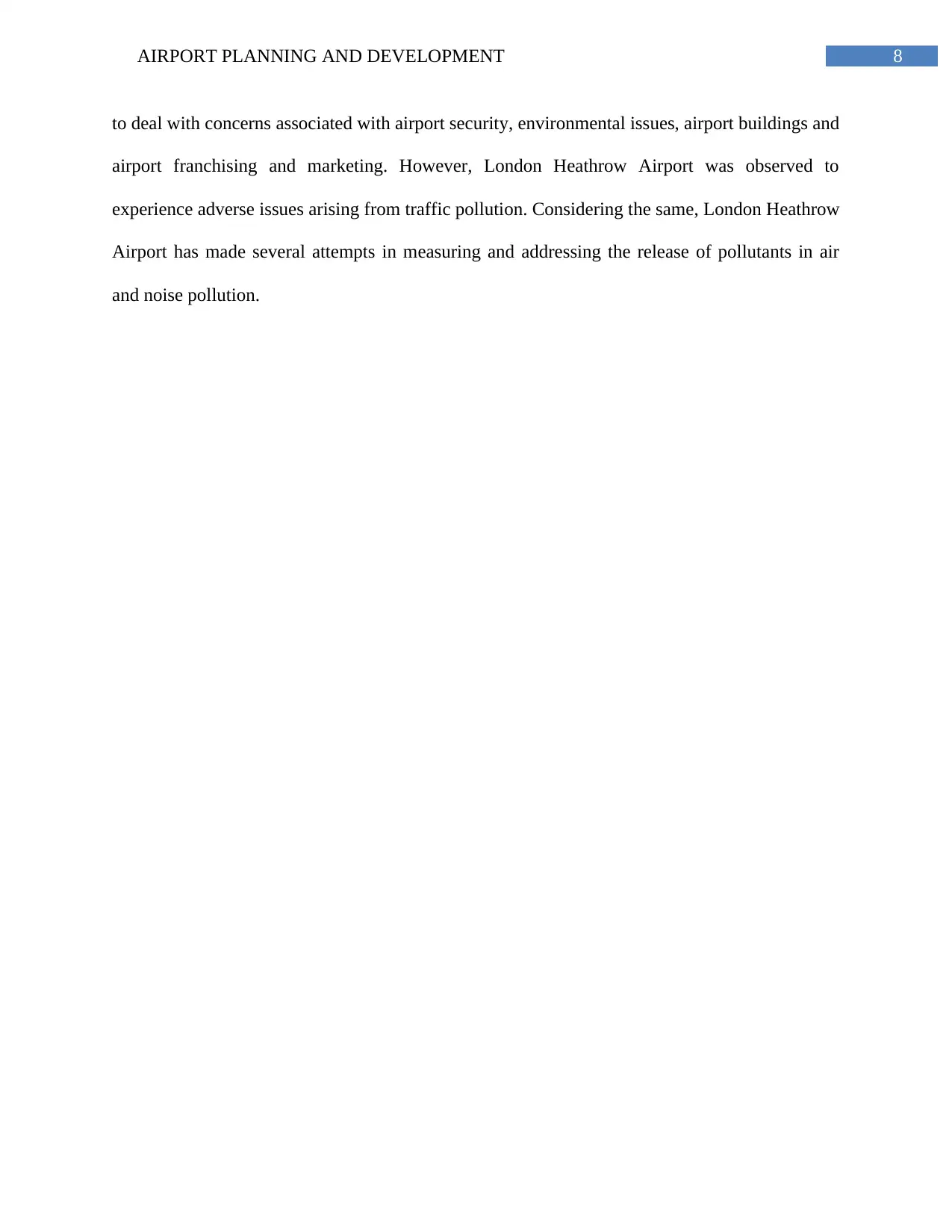
8AIRPORT PLANNING AND DEVELOPMENT
to deal with concerns associated with airport security, environmental issues, airport buildings and
airport franchising and marketing. However, London Heathrow Airport was observed to
experience adverse issues arising from traffic pollution. Considering the same, London Heathrow
Airport has made several attempts in measuring and addressing the release of pollutants in air
and noise pollution.
to deal with concerns associated with airport security, environmental issues, airport buildings and
airport franchising and marketing. However, London Heathrow Airport was observed to
experience adverse issues arising from traffic pollution. Considering the same, London Heathrow
Airport has made several attempts in measuring and addressing the release of pollutants in air
and noise pollution.
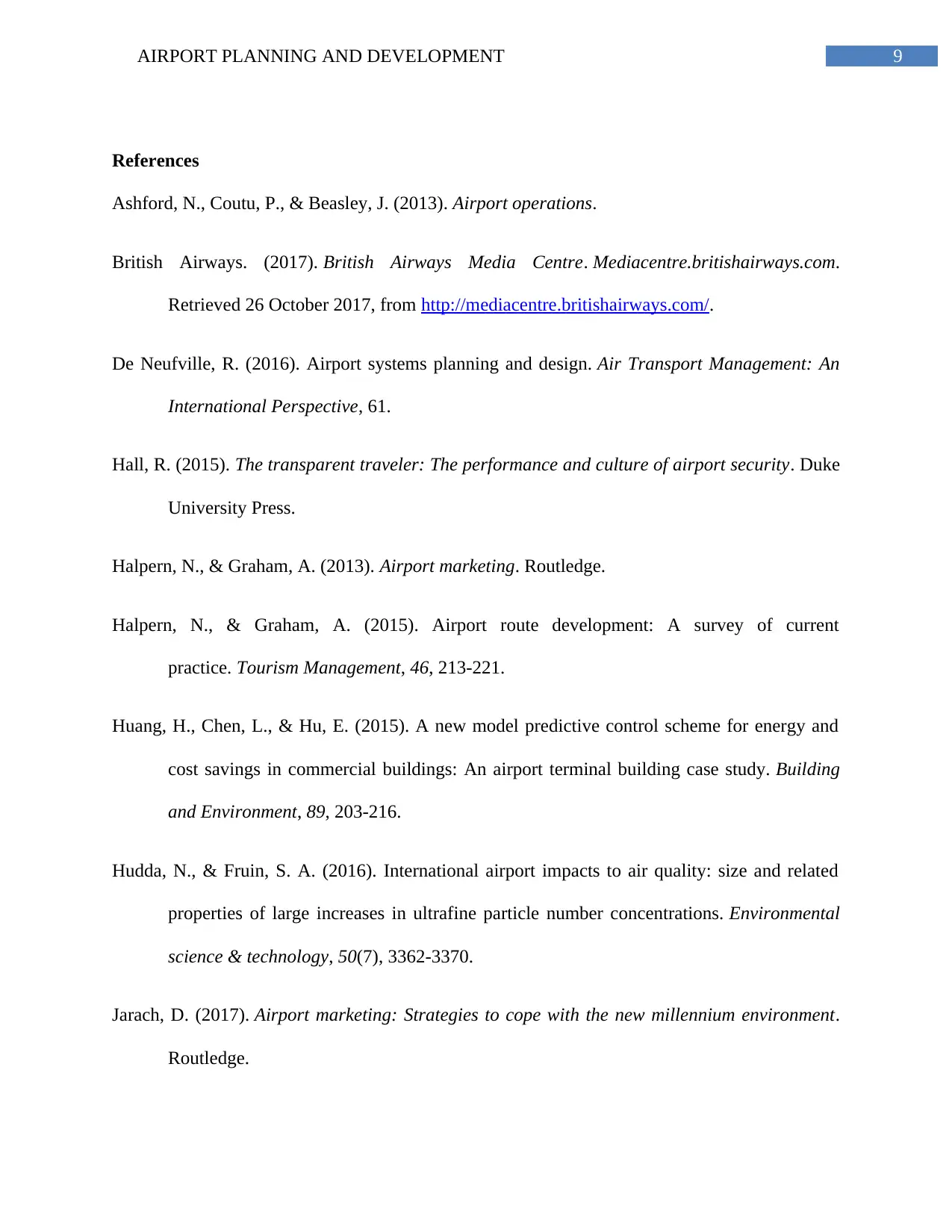
9AIRPORT PLANNING AND DEVELOPMENT
References
Ashford, N., Coutu, P., & Beasley, J. (2013). Airport operations.
British Airways. (2017). British Airways Media Centre. Mediacentre.britishairways.com.
Retrieved 26 October 2017, from http://mediacentre.britishairways.com/.
De Neufville, R. (2016). Airport systems planning and design. Air Transport Management: An
International Perspective, 61.
Hall, R. (2015). The transparent traveler: The performance and culture of airport security. Duke
University Press.
Halpern, N., & Graham, A. (2013). Airport marketing. Routledge.
Halpern, N., & Graham, A. (2015). Airport route development: A survey of current
practice. Tourism Management, 46, 213-221.
Huang, H., Chen, L., & Hu, E. (2015). A new model predictive control scheme for energy and
cost savings in commercial buildings: An airport terminal building case study. Building
and Environment, 89, 203-216.
Hudda, N., & Fruin, S. A. (2016). International airport impacts to air quality: size and related
properties of large increases in ultrafine particle number concentrations. Environmental
science & technology, 50(7), 3362-3370.
Jarach, D. (2017). Airport marketing: Strategies to cope with the new millennium environment.
Routledge.
References
Ashford, N., Coutu, P., & Beasley, J. (2013). Airport operations.
British Airways. (2017). British Airways Media Centre. Mediacentre.britishairways.com.
Retrieved 26 October 2017, from http://mediacentre.britishairways.com/.
De Neufville, R. (2016). Airport systems planning and design. Air Transport Management: An
International Perspective, 61.
Hall, R. (2015). The transparent traveler: The performance and culture of airport security. Duke
University Press.
Halpern, N., & Graham, A. (2013). Airport marketing. Routledge.
Halpern, N., & Graham, A. (2015). Airport route development: A survey of current
practice. Tourism Management, 46, 213-221.
Huang, H., Chen, L., & Hu, E. (2015). A new model predictive control scheme for energy and
cost savings in commercial buildings: An airport terminal building case study. Building
and Environment, 89, 203-216.
Hudda, N., & Fruin, S. A. (2016). International airport impacts to air quality: size and related
properties of large increases in ultrafine particle number concentrations. Environmental
science & technology, 50(7), 3362-3370.
Jarach, D. (2017). Airport marketing: Strategies to cope with the new millennium environment.
Routledge.
Secure Best Marks with AI Grader
Need help grading? Try our AI Grader for instant feedback on your assignments.
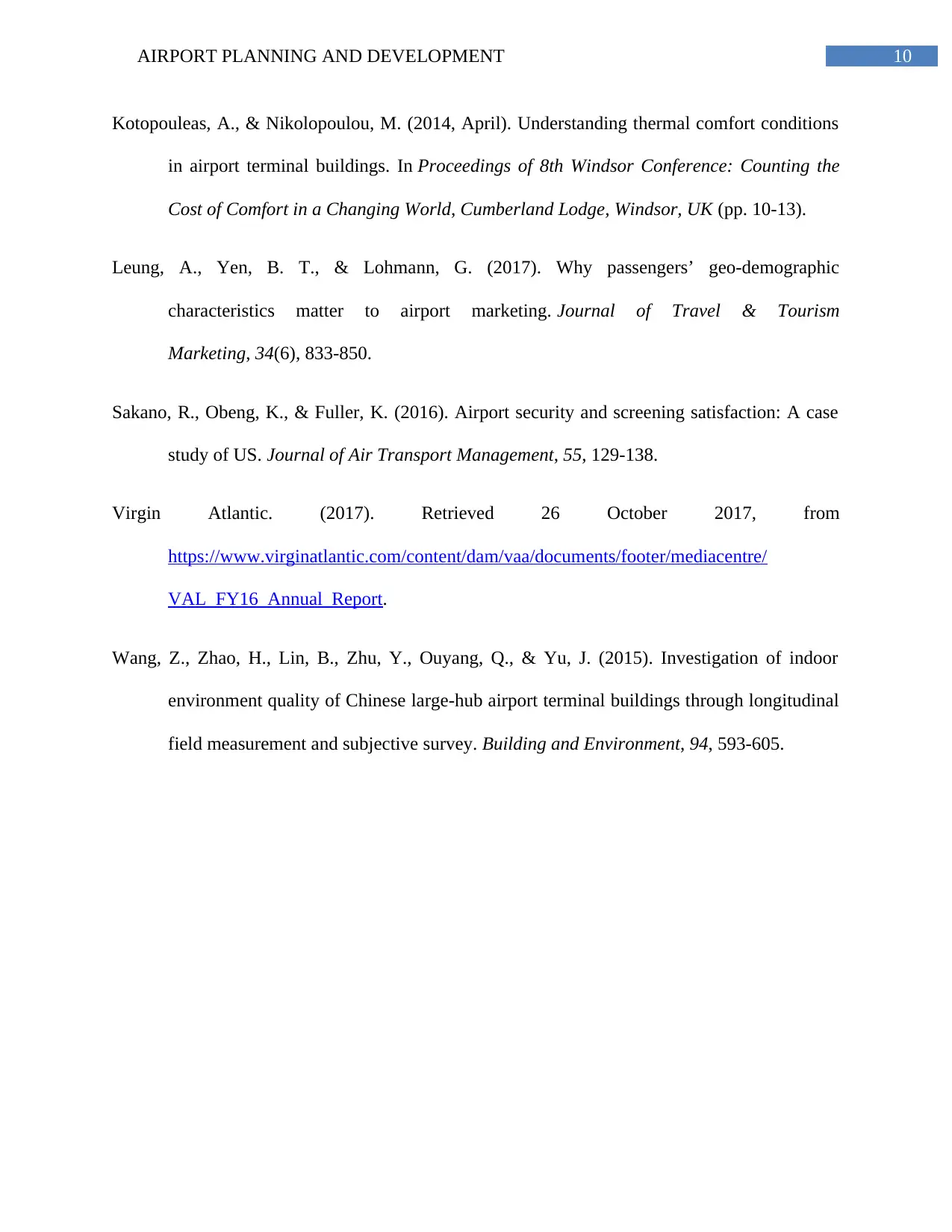
10AIRPORT PLANNING AND DEVELOPMENT
Kotopouleas, A., & Nikolopoulou, M. (2014, April). Understanding thermal comfort conditions
in airport terminal buildings. In Proceedings of 8th Windsor Conference: Counting the
Cost of Comfort in a Changing World, Cumberland Lodge, Windsor, UK (pp. 10-13).
Leung, A., Yen, B. T., & Lohmann, G. (2017). Why passengers’ geo-demographic
characteristics matter to airport marketing. Journal of Travel & Tourism
Marketing, 34(6), 833-850.
Sakano, R., Obeng, K., & Fuller, K. (2016). Airport security and screening satisfaction: A case
study of US. Journal of Air Transport Management, 55, 129-138.
Virgin Atlantic. (2017). Retrieved 26 October 2017, from
https://www.virginatlantic.com/content/dam/vaa/documents/footer/mediacentre/
VAL_FY16_Annual_Report.
Wang, Z., Zhao, H., Lin, B., Zhu, Y., Ouyang, Q., & Yu, J. (2015). Investigation of indoor
environment quality of Chinese large-hub airport terminal buildings through longitudinal
field measurement and subjective survey. Building and Environment, 94, 593-605.
Kotopouleas, A., & Nikolopoulou, M. (2014, April). Understanding thermal comfort conditions
in airport terminal buildings. In Proceedings of 8th Windsor Conference: Counting the
Cost of Comfort in a Changing World, Cumberland Lodge, Windsor, UK (pp. 10-13).
Leung, A., Yen, B. T., & Lohmann, G. (2017). Why passengers’ geo-demographic
characteristics matter to airport marketing. Journal of Travel & Tourism
Marketing, 34(6), 833-850.
Sakano, R., Obeng, K., & Fuller, K. (2016). Airport security and screening satisfaction: A case
study of US. Journal of Air Transport Management, 55, 129-138.
Virgin Atlantic. (2017). Retrieved 26 October 2017, from
https://www.virginatlantic.com/content/dam/vaa/documents/footer/mediacentre/
VAL_FY16_Annual_Report.
Wang, Z., Zhao, H., Lin, B., Zhu, Y., Ouyang, Q., & Yu, J. (2015). Investigation of indoor
environment quality of Chinese large-hub airport terminal buildings through longitudinal
field measurement and subjective survey. Building and Environment, 94, 593-605.
1 out of 11
Your All-in-One AI-Powered Toolkit for Academic Success.
+13062052269
info@desklib.com
Available 24*7 on WhatsApp / Email
![[object Object]](/_next/static/media/star-bottom.7253800d.svg)
Unlock your academic potential
© 2024 | Zucol Services PVT LTD | All rights reserved.


